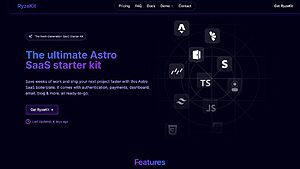Taxonomy is an open-source web application template designed to showcase the latest features and best practices in modern web development. Built using Next.js 13, it serves as an experimental playground for developers, allowing them to explore various concepts and technologies within a single cohesive project.
Key Features
- Next.js 13: Taxonomy leverages the power of Next.js 13, the latest version of this popular React framework. Here are some highlights:
- Server Components: Taxonomy demonstrates the use of server components, enabling dynamic rendering on the server side. This feature enhances performance and reduces client-side JavaScript execution.
- API Routes: The template includes custom API routes for handling backend logic. These routes can be used for data fetching, authentication, and other server-side tasks.
- Static Pages: Taxonomy embraces static site generation (SSG) for improved performance and SEO. Static pages are pre-rendered during build time, resulting in faster load times.
- React 18 Server and Client Components: Taxonomy adopts React 18’s server and client components, allowing developers to build more interactive and efficient user interfaces.
- Prisma: The template integrates Prisma, a powerful database ORM. Prisma simplifies database interactions, provides type-safe queries, and supports various databases (such as PostgreSQL, MySQL, and SQLite).
- Radix UI and Tailwind CSS: Taxonomy’s user interface (UI) components are crafted using Radix UI, a set of accessible and customizable UI primitives. Tailwind CSS handles styling, making it easy to create responsive and visually appealing designs.
- NextAuth.js: Authentication is a critical aspect of any web application. Taxonomy employs NextAuth.js to handle user authentication, including features like OAuth providers, JWT tokens, and session management.
- Stripe Integration: For subscription-based services, Taxonomy integrates with Stripe. Developers can set up free and paid subscription plans, manage billing, and handle payment processing seamlessly.
- Content layer and MDX: Taxonomy goes beyond the basics by including a blog and a comprehensive documentation site. Content layer, combined with MDX (Markdown with JSX), allows developers to create rich content with ease.
Use Cases
- Learning Playground: Taxonomy is an excellent resource for developers who want to explore cutting-edge technologies. Whether you’re new to Next.js or an experienced developer, you’ll find valuable insights by studying its codebase.
- Starter Template: Use Taxonomy as a starting point for your own projects. Customize it according to your requirements, add new features, and build upon the solid foundation it provides.
- Educational Material: The included blog and documentation site can serve as educational material for learning about Next.js, React, and related technologies.




